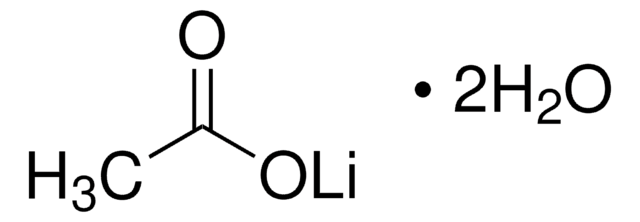88276
Poli(etilenglicol)
BioUltra, 3,350
Sinónimos:
PEG
About This Item
Productos recomendados
Nivel de calidad
Línea del producto
BioUltra
Formulario
powder
mol peso
Mr 3000-3700
impurezas
insoluble matters, passes filter test
pH
5.5-7.0 (25 °C, 50 mg/mL in H2O)
solubilidad
H2O: 50 mg/mL, clear, colorless
trazas de anión
chloride (Cl-): <50 mg/kg
sulfate (SO42-): <50 mg/kg
trazas de catión
Al: ≤5 mg/kg
As: ≤0.1 mg/kg
Ba: ≤5 mg/kg
Bi: ≤5 mg/kg
Ca: ≤5 mg/kg
Cd: ≤5 mg/kg
Co: ≤5 mg/kg
Cr: ≤5 mg/kg
Cu: ≤5 mg/kg
Fe: ≤5 mg/kg
K: ≤200 mg/kg
Li: ≤5 mg/kg
Mg: ≤5 mg/kg
Mn: ≤5 mg/kg
Mo: ≤5 mg/kg
Na: ≤200 mg/kg
Ni: ≤5 mg/kg
Pb: ≤5 mg/kg
Sr: ≤5 mg/kg
Zn: ≤5 mg/kg
λ
50 mg/mL in H2O
Absorción UV
λ: 260 nm Amax: 0.06
λ: 280 nm Amax: 0.03
cadena SMILES
C(CO)O
InChI
1S/C2H6O2/c3-1-2-4/h3-4H,1-2H2
Clave InChI
LYCAIKOWRPUZTN-UHFFFAOYSA-N
¿Está buscando productos similares? Visita Guía de comparación de productos
Descripción general
Aplicación
- to grow the crystals of HLA-A∗02:01-N222-230 LLLDRLNQL (pHLA) complex
- in the fabrication of ultrathin, free-standing, and porous polymer membranes for retinal tissue engineering
- to grow the crystals of the C2c2-crRNA complex
- to grow the crystals of the apo-C2c2 thermolysin-resistant core
Acciones bioquímicas o fisiológicas
Características y beneficios
- Environment friendly
- Biocompatible
- Unique solvent solution
Código de clase de almacenamiento
11 - Combustible Solids
Clase de riesgo para el agua (WGK)
WGK 1
Punto de inflamabilidad (°F)
Not applicable
Punto de inflamabilidad (°C)
Not applicable
Equipo de protección personal
Eyeshields, Gloves, type N95 (US)
Elija entre una de las versiones más recientes:
¿Ya tiene este producto?
Encuentre la documentación para los productos que ha comprado recientemente en la Biblioteca de documentos.
Los clientes también vieron
Nuestro equipo de científicos tiene experiencia en todas las áreas de investigación: Ciencias de la vida, Ciencia de los materiales, Síntesis química, Cromatografía, Analítica y muchas otras.
Póngase en contacto con el Servicio técnico
